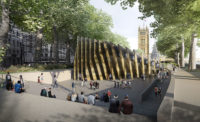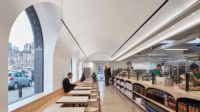How do you speak of the unspeakable? That is the aesthetic conundrum posed by every memorial to the holocaust. Daniel Libeskind, principal of Studio Libeskind, based in New York, took on this challenge for Canada’s National Holocaust Monument, which opened in October 2017 in the capital city of Ottawa. The competition-winning scheme, commemorating victims of the Nazi genocide and recognizing the 40,000 survivors who made it to Canada, owes a debt to Libeskind’s seminal Jewish Museum in Berlin, completed in 1999. Each has few right angles, and both are designed to create a sense of unease that is relevant to the history they evoke. This new project—an open-air, poured-concrete pavilion that sits across the street from the Canadian War Museum (2008) by Moriyama & Teshima with Griffiths Rankin Cook—is meant to be a public place of respite and reflection.
Additional Content:
Jump to credits & specifications
Seen from above, the assembly of six outdoor “rooms” reads as a distorted version of the Star of David, which the Nazis forced the Jews to wear to identify themselves. From the streets bounding it, the monument appears as a set of three monoliths, each leaning in a different direction behind a low diagonal wall. As you approach the main entrance, you angle around and arrive at a central plaza, where you find a series of panels explaining the history of the holocaust. The surrounding concrete walls slant alternately inward and outward, providing both a sense of enclosure and a feeling of dissonance. “You don’t need to know the history of memorials to understand that you’re in a space that is transmitting a certain spirit,” Libeskind says. The secluded central plaza, with its acute angles and contemplative character, is quite beautiful, if disquieting.
Art on the walls heightens that sense and provides direct connection to Eastern European sites of the holocaust. The photographer Edward Burtynsky documented a series of places linked to the genocide, and six of these images are subtly hand-painted onto the concrete. They include a rail bed that led to the Treblinka death camp; a fence at Auschwitz; and a prayer room created by Jewish inmates at the Theresienstadt ghetto. Branching off from that major open space are a series of alcoves. The tallest—almost entirely enclosed—houses a “Flame of Remembrance.”
Throughout the $6.4 million project, the architects specified various finishes of concrete to retain some of the material’s imperfections. “The textures of the surfaces add to the effect,” says Carla Swickerath, the partner in charge of the project, so that “the monument will resonate with people physically as well as intellectually.” Pathways are defined by particularly coarse aggregate; one of these leads to an elongated straight stair taking you up and out of the central plaza to the street. The stair also rises in a manner that frames the view of a landmark in the distance—the Gothic-style Peace Tower that caps the center block of Canada’s parliament buildings. This is no accident. The government wants the holocaust to remain in the memories of Canadians. At the grand opening this past fall, Prime Minister Justin Trudeau cited Canada’s mixed record during World War II, when the country turned away hundreds of Jewish refugees. As Libeskind says, “There’s a certain urgency about what these walls communicate, because we are living in a world that is threatened by totalitarianism, by deprivation of human rights, by xenophobia, racism, and anti-Semitism. It’s not a neutral space. It is a space full of conflict and rejection.” He has forcefully created an architecture that pushes beyond words.
CreditsArchitect: Daniel Libeskind
Personnel in architect's firm who should receive special credit: Carla Swickerath, Partner Toralf Sümmchen, Senior Associate Jason Jimenez, Senior Associate Jesse Bernard, Architectural Designer
Landscape Architect: Claude Cormier + Associés (Montréal)
Engineers Structural Engineer: Read Jones Christofferson (Toronto and Ottawa) Electrical, mechanical and civil engineer: WSP (Ottawa)
Consultants Lead Cultural Consultants: Lord Cultural Resources Photography: Edward Burtynsky (Toronto)
General contractor: UCC Group (Toronto)
Photographer: Doublespace photography |
SpecificationsStructural System Manufacturer of any structural components unique to this project: For the geometrically most challenging walls Lafarge Agilia Self Consolidating Concrete was used.
Exterior Cladding Metal panels: Custom made galvanized steel panels for the guardrails of the Stair of Hope and the connecting pathway between elevator and upper level, manufactured and installed by subcontractor DYMECH Engineering Inc.
Merlin Door Systems
Hardware Locksets: Corbin Russwin https://www.corbinrusswin.com/en/site/corbin-russwin/ Ecosense EcoSpec Floodlight Wash BEGA LED recessed luminaires Eklipse Horizon Wet Iguzzini Linealuce Compact Iguzzini iWay light bollard
Elevators/Escalators Garaventa Elvoron LULA Elevator |










Post a comment to this article
Report Abusive Comment